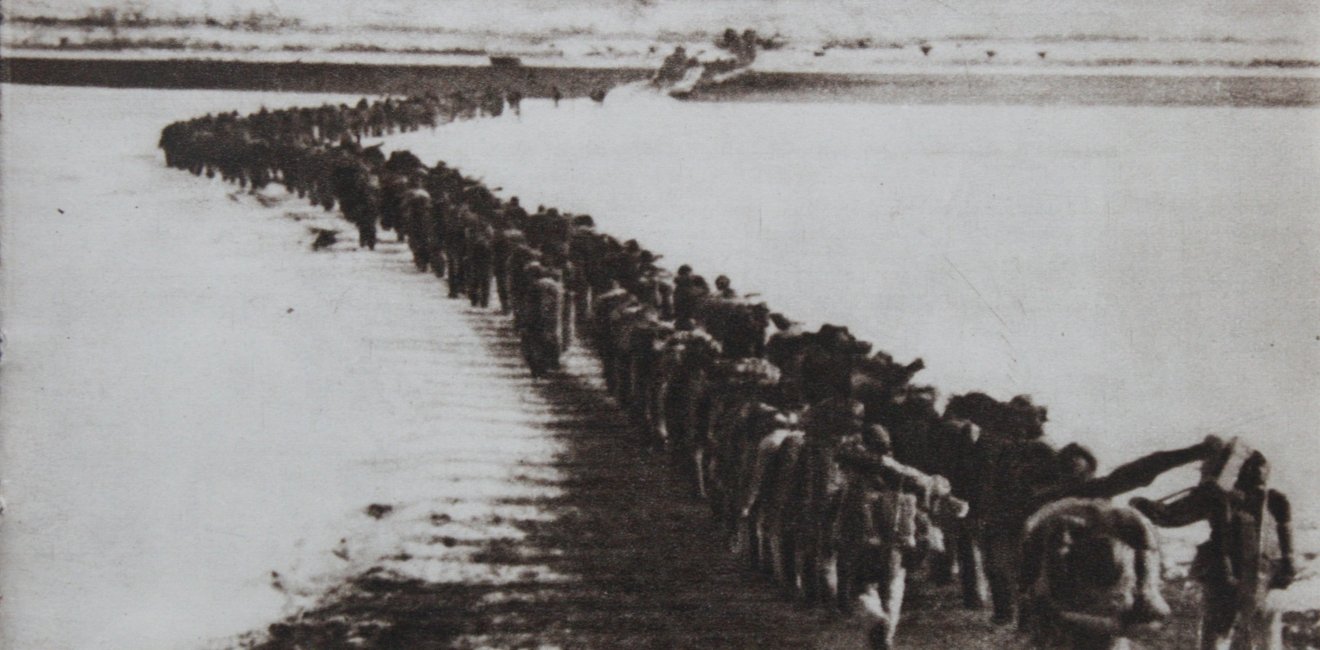China, North Korea, and the Origins of the Korean War
How China did, and did not, push Kim Il Sung towards war.

A blog of the History and Public Policy Program
How China did, and did not, push Kim Il Sung towards war.

Relations between the Chinese Communist Party and North Korea prior to October 1949 – the month of the founding of the People’s Republic of China – were extensive, even if they were not always centrally coordinated.
The North Koreans followed military developments in China closely, probably recognizing that the outcome of the conflict next door would shape developments in their own country and across East Asia. There were meaningful interactions along the Sino-Korean border from August 1945 onward. Kim Il Sung lent support to Chinese Communist troops fighting in Manchuria in 1946-1947. During the same period, the CCP dispatched personnel to Pyongyang to boost communication with the Korean Workers’ Party.
Of course, with China in the midst of a civil war and North Korea still a very young state, relations between the two sides had room to grow. Answering a question from Joseph Stalin in March 1949, Kim noted with some disappointment that because “China is at war,” it was not yet a reliable partner for his country. This would come later, after the founding of the People’s Republic of China.
One of the key questions about China-North Korea relations during this period concerns the extent to which Mao Zedong was aware of – and whether he encouraged – Kim Il Sung’s plans to unify the Korean Peninsula through force.
Mao certainly was aware of Kim’s aspirations to rule over the entire Korean Peninsula. In April and May 1949, Kim Il Sung sent a high-level emissary to China – confusingly, someone named Kim Il – to discuss the matter. Kim Il first traveled to Shenyang and met Gao Gang, the head of the CCP’s operations in the northeast, and subsequently to Beiping to brief the CCP’s chief leaders: Mao Zedong, Zhou Enlai, and Zhu De.
Kim Il’s meetings have not officially been disclosed by Chinese or North Korean authorities, but they are the subject of two Soviet cables: one sent from Pyongyang by Ambassador Shtykov, the other sent from Stalin’s personal representative in China, Ivan Kovalev.
According to both Soviet records, Mao was eager to help the North Koreans. The CCP Chairman pledged to transfer up to three divisions of Korean soldiers – weapons in tow – from his own army to the Korean People’s Army. When Kim Il asked about receiving extra ammunition for the troops, Mao reportedly said he would “give to the Koreans as much as they need.” Mao’s pledges would certainly boost the fighting capacity of the KPA.
Mao also signaled his interest in expanding commercial ties with the DPRK. He tapped Gao Gang to take the lead on such initiatives with North Korea.
Given Mao’s offer of military assistance, might he have been entertaining war in Korea at this time?
According to Terentii Shtykov’s account: yes, absolutely. Shtykov reported (presumably based on subsequent debriefings from Kim Il and Kim Il Sung) that Mao had said that “Korea could see military action at any moment.” Mao reassured Kim Il, noting that the North Koreans could count on support from the Soviet Union and China. Mao also purportedly remarked that Chinese soldiers could fight alongside North Korea’s army, and the enemy (the Americans) would be none the wiser. “They are all black-[haired],” Mao crudely joked.
But Kovalev’s report casts Mao in a much more restrained light. “We do not advise the Korean comrades to mount an attack on South Korea in this situation,” Mao explained.
Mao had several reservations. He apparently believed that the United States would mobilize Japanese forces to participate in a counterattack. He also claimed that the CCP could not “give quick substantial support” at this time, due its own war that was still raging in the south of China. Perhaps by the beginning of 1950, after Chiang Kai-shek’s forces had been fully defeated, conditions would be riper. Mao reminded Kim Il that, of course, such a decision could be reached only after “coordinating” with Stalin.
Judging from subsequent remarks made by Mao, the latter account seems more plausible. In October 1949, Mao shared with Stalin his frustration that the North Koreans were not heeding his words closely enough. Mao apparently learned, via intelligence collected by the CCP, that the North Koreans had been taking steps since June to launch a military offensive against the south. They had even sent “large groups of cadre to South Korea to perform underground work in order to prepare an action in October.”
The uprising that the North Koreans were counting on that summer or fall came to naught. Mao was irritated. He believed the North Koreans had seriously erred, and were now at a political disadvantage vis-à-vis South Korea and the United States. “This spring I gave advice to a representative of North Korea,” he confided in Stalin, that “they ought to take a defensive position and that they ought not wage an offensive for the time being.”
Mao concluded that the North Koreans “were hasty and did not think over how to follow my advice.”
Stalin’s trademark blue pencil markings on the report show that Mao’s criticisms of Kim Il Sung registered with the Soviet leader. “The Korean Army ought not to pursue an attack at the present time,” Stalin wrote back to Mao in agreement.
This dispute notwithstanding, relations between China and North Korea matured over the next several months. In early October, Stalin encouraged the PRC and the DPRK to exchange diplomatic relations. The North Korean request arrived on October 4, and Zhou Enlai responded positively two days later.
The two countries took various steps to expand ties. They shuttered the sub-national trade offices that North Korea operated in Shenyang and the CCP’s Northeast Bureau operated in Pyongyang, recognizing that such matters could now receive adequate attention from their respective national ministries of trade. North Korea put out requests to purchase Chinese coal. The two sides devised ways to regulate cross-border traffic. The PRC accepted the appointment of Ri Ju-yeon as the first DPRK ambassador to China. North Korea invited Chinese doctors to participate in a conference in Pyongyang.
Perhaps most significantly, the Chinese fulfilled their pledge to send Korean soldiers from the PLA to the DPRK. In a report from late 1949 (this one also eventually shared with Stalin), famed Chinese military leader Lin Biao wrote that 16,000 Korean troops were ready to be transferred to the Korean People’s Army. “In the interests of the Korean people,” Lin exclaimed, “we should send these trained cadres back to Korea.” China’s Central Military Commission concurred less than two weeks later. Mao himself signed off on the order before the end of January.
By this time, Kim Il Sung could not get war off his mind. He began pestering his communist mentors, Mao and Stalin, to support a southern invasion.
No doubt Mao’s victory in the Chinese Civil War motivated Kim. The North Korean leader “underscored,” according to Soviet diplomats, that “Mao Zedong promised to render him assistance after the conclusion of the war in China.”
In March, Kim asked to visit both the Soviet Union and China. The North Korean ambassador in Beijing, Ri Ju-yeon (Ri Ju Yon), tendered the request during an audience with Mao. Mao agreed. He told Ri that if Kim planned to raise “the question of the unification of Korea,” then he should travel to China secretly.
After some additional back-and-forth, the two sides settled on May 13 as the date for a closed-door meeting between Mao and Kim. By this time, Mao fully understood that their talk would concern Kim’s “intentions about unifying the country by military means.”
But would Mao support such a plan?
The Chinese and North Korean records of Kim’s visit to Beijing are, of course, still secret. Even the excruciatingly detailed, day-by-day chronology of Mao’s life – prepared by Chinese Communist Party historians with privileged access to sources – neglects to mention the encounter.
It is only through Soviet archives that we can piece together Mao’s response. The Chinese shared their impressions of Kim with Soviet interlocutors. Zhou Enlai informed Ambassador Roshchin that Kim had spoken about the “the directives of comrade Filippov” (a pseudonym for Joseph Stalin), who said that “the present situation has changed from the situation in the past and, that North Korea can move toward actions.”
Zhou asked Roshchin to confirm that this is really what Stalin had said; that is, whether Stalin had in fact given a green light for a North Korean invasion of the south.
Very early on the morning of May 14, Stalin wrote directly to Mao. “In light of the changed international situation,” Stalin explained, “[I] agree with the proposal of the Koreans to move toward reunification.”
Although Stalin approved, he left the final decision to Mao, writing that “the question should be decided finally by the Chinese and Korean comrades together.” Should Mao and the Chinese leadership dissent, “the decision on the question [of war] should be postponed.”
Given what took place on June 25, 1950, Mao must have signed off. But we are on shakier ground when it comes to determining why he supported Kim’s gambit.
For one, Mao was probably wary of disagreeing with Stalin on such a significant matter. As the archival record of China-North Korea relations during this period plainly demonstrates, leaders in both countries were extremely wary of going over Stalin’s head. Mao told Stalin about almost every interaction between the two countries. Stalin, hardly a passive recipient of information, weighed in frequently. He gave advice to Mao (and Kim) often, and Mao usually followed it.
Joseph Stalin had his hands all over China-North Korea relations before the start of the Korean War on June 25, 1950.
But there may have been something else that motivated Mao.
At this stage, Kim Il Sung had nothing but admiration for China. He earnestly desired to replicate Mao’s successful war of “liberation.” In January 1950, Kim told two Soviet diplomats – “in an excited manner” – that now that China had completed its war, “the liberation of the Korean people in the south of the country is next in line.” How could Mao turn away an earnest supporter wishing to replicate the Chinese experience?
Mao’s sense of pride may have prompted him to agree to a conflict, one that would ultimately embroil China and lead to hundreds of thousands of Chinese casualties.


A leader in making key foreign policy records accessible and fostering informed scholarship, analysis, and discussion on international affairs, past and present. Read more


The North Korea International Documentation Project serves as an informational clearinghouse on North Korea for the scholarly and policymaking communities, disseminating documents on the DPRK from its former communist allies that provide valuable insight into the actions and nature of the North Korean state. Read more


The Cold War International History Project supports the full and prompt release of historical materials by governments on all sides of the Cold War. Read more



